Agra, India
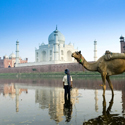
Namaste! Welcome to India! Arrive Delhi after clearing all immigration and customs formalities, our representative will meet you in the arrival hall .. He/She would assist you at airport & transfer to hotel for check in.
Agra is a city on the banks of the river Yamuna in the northern state of Uttar Pradesh, India. It is 363 kilometres (226 mi) west of the state capital, Lucknow, 200 kilometres (124 mi) south of the national capital New Delhi and 125 kilometres (78 mi) north of Gwalior. With a population of 1,686,976 (2010 est.), it is one of the most populous cities in Uttar Pradesh and the 19th most populous in India. Agra can also refer to the administrative district that has its headquarters in Agra city. It is a major tourist destination because of its many splendid Mughal-era buildings, most notably the Tāj Mahal, Agra Fort and Fatehpūr Sikrī, all three of which are UNESCO World Heritage Sites. Agra is included on the Golden Triangle tourist circuit, along with Delhi and Jaipur.
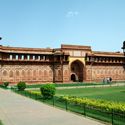
Delhi (also known as the National Capital Territory of India) is a metropolitan region in India. With a population of 22 million in 2011, it is the world's second most populous city and the largest city in India in terms of area. Delhi is a city that bridges two different worlds. Old Delhi, once the capital of Islamic India, is a labyrinth of narrow lanes lined with crumbling havelis and formidable mosques. In contrast, the imperial city of New Delhi created by the British Raj is composed of spacious, tree-lined avenues and imposing government buildings. The city's importance lies not just in its past glory as the seat of empires and magnificent monuments, but also in the rich and diverse cultures.
Taj Mahal
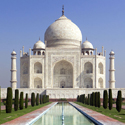
Upon arrival in Agra you will be met and escorted to your hotel for check-in etc. Afternoon, you are collected from your hotel for a half-day tour of Agra visiting The Taj Mahal - a poem, a feeling of love, in white marble, is a fine example of the fusion of many architectural styles. It has been described as the most extravagant monument ever built for love. Your tour also includes a visit to the Red Sandstone Agra Fort, seat of the Mughal dynasty in the 16th century, lies on the bend of the River Yamuna, almost in the heart of town. Akbar built it as his citadel over the years of 1565-1573.
Come, walk along the pathway beside the reflecting pool with fountains upto the mausoleum crafted in soft & pure marble and jewelled with semi precious stones, where in the serenity of paradise rests the Queen in peace with her King. Come to unfold the pages from the past to churn the charm out of its mystique and enrich your imagination about this marvel of an epic in stone, The Taj! The grace of perfection of proportions and grandeur of geometrical patterns of well appointed gardens enhancing the poise of the whole complex together add magnificence to the delicacy of this mance of love, dedication and purity, 'The Taj'!
Come take a dip into the saga of 'The Taj', culled out from no fiction but facts and unfurl a saga, which is set out of nothing but pure love!Beauty lies in the eyes of the beholder! Probably for Taj Mahal, the axiom is just the other way round.The Taj is the beauty personified! The Taj displays its different moods through its varied shades. The Taj has as many shades as any kind of beauty can ever have! The Taj is pinkish in the morning, milky white in the evening, golden when the moon shines and the intermediary variants during different hours of the day and during different seasons in a year. Picturesque descriptions by the historians contemporary to the period of its making, the facts revealed by the scholars & archaeologists of today and the panoramic montage of the reasons behind its making are sketched with every step you would walk towards the mausoleum the next time you visit The Taj!
Agra Fort
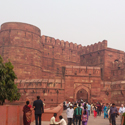
An era marked by invasions and fortifications, where power was symbolized by grand palaces and grander forts during such time was built THE AGRA FORT. Fortification has always been and still is the prerogative of the mighty; the dividing line between the ruler and the ruled. The mighty towers and overwhelming facades instilling fear and awe in the bravest of the brave.yet there were the few who overcame the daunting adversities and made their mark in history, a signature. that still exists. Structures built as a sign of prowess remind us all of the grit and valour of the brave men and women who captured, destroyed and built such overwhelming edifices. The Agra Fort, also known as the "Lal –Qila", "Fort Rouge" or "Qila-i-Akbari", is the highlight of the city of Agra, then capital of the Mughal Sultanate . A symbol of power, strength and resilience, as it stands today in full glory.
The present-day structure was built by the Mughals, though a fort had stood there since at least the 11th century. Agra Fort was originally a brick fort known as Badalgarh, held by Raja Badal Singh Hindu Sikarwar Rajput king (c. 1475). It was mentioned for the first time in 1080 AD when a Ghaznavide force captured it. Sikandar Lodi (1488–1517) was the first Sultan of Delhi who shifted to Agra and lived in the fort. He governed the country from here and Agra assumed the importance of the second capital. He died in the fort at 1517 and his son, Ibrahim Lodi, held it for nine years until he was defeated and killed at Panipat in 1526. Several palaces, wells and a mosque were built by him in the fort during his period.
Tomb of Akbar
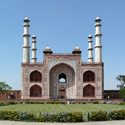
The third Mughal Emperor Akbar the Great (1555–1605), himself commenced its construction in around 1600, according to Tartary tradition to commence the construction of one's tomb during one's lifetime. Akbar himself planned his own tomb and selected a suitable site for it. After his death, Akbar's son Jahangir completed the construction in 1605-1613. Akbar was one of the greatest emperors in the history of India.
It is located at Sikandra, in the suburbs of Agra, on the Mathura road (NH2), 8 km west-northwest of the city center. About 1 km away from the tomb, lies Mariam's Tomb, the tomb of Mariam-uz-Zamani, wife of the Mughal Emperor Akbar and the mother of Jahangir.
The south gate is the largest, with four white marble chhatri-topped minarets which are similar to (and pre-date) those of the Taj Mahal, and is the normal point of entry to the tomb. The tomb itself is surrounded by a walled enclosure 105 m square. The tomb building is a four-tiered pyramid, surmounted by a marble pavilion containing the false tomb. The true tomb, as in other mausoleums, is in the basement. The buildings are constructed mainly from a deep red sandstone, enriched with features in white marble. Decorated inlaid panels of these materials and a black slate adorn the tomb and the main gatehouse. Panel designs are geometric, floral and calligraphic, and prefigure the more complex and subtle designs later incorporated in Itmad-ud-Daulah's Tomb.
Jama Masjid
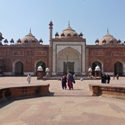
Jama Masjid in Agra is opposite the Agra fort and overlooking the Agra Fort Railway Station. The Jama Masjid is also popularly known as the Jami Masjid or "Friday Mosque". It is one of the larger mosques in India.
The Mosque was built by Mughal emperor, Shahjahan in 1648 and dedicated to his favourite daughter, Jahanara Begum. There was a spacious, octagonal Tripolia Chowk which existed between the Jama Masjid and the Delhi gate of the Agra Fort. This Tropolia was destroyed in order to create the Agra Fort Railway Station. The cloisters have engrailed arches supported on pillars. The main entrance is through the eastern side. The prayer chamber has a façade with a broad arched iwan in its centre and is adorned with slender turrets alternated with kiosks. Its dome is the largest and highest of the three domes crowning the sanctuary.
